Sony SGP561 User Manual

User guide
Xperia™ Z2 Tablet
SGP561
Contents
Getting started............................................................................... |
5 |
About this User guide.......................................................................... |
5 |
Tablet Features................................................................................... |
5 |
Setting Up Your Tablet........................................................................ |
6 |
Starting your device for the first time................................................... |
8 |
Why do I need a Google™ account?................................................... |
8 |
Charging Your Tablet.......................................................................... |
8 |
Learning the basics...................................................................... |
10 |
Using the touchscreen...................................................................... |
10 |
Locking and unlocking the screen..................................................... |
11 |
Home screen.................................................................................... |
12 |
Application screen............................................................................. |
13 |
Navigating applications..................................................................... |
14 |
Small apps........................................................................................ |
14 |
Widgets............................................................................................ |
15 |
Shortcuts and folders........................................................................ |
16 |
Background and themes................................................................... |
17 |
Status and notifications..................................................................... |
17 |
Icons in the status bar....................................................................... |
18 |
Application overview......................................................................... |
20 |
Downloading applications............................................................ |
21 |
Downloading applications from Google Play™.................................. |
21 |
Downloading applications from other sources................................... |
21 |
Internet and networks.................................................................. |
22 |
Browsing the web............................................................................. |
22 |
Wi-Fi®.............................................................................................. |
22 |
Sharing your mobile data connection................................................ |
23 |
Controlling data usage...................................................................... |
24 |
Virtual private networks (VPNs).......................................................... |
25 |
Synchronizing data on your device.............................................. |
27 |
Synchronizing with online accounts................................................... |
27 |
Synchronizing with Microsoft® Exchange ActiveSync®..................... |
27 |
Basic settings............................................................................... |
29 |
Accessing settings............................................................................ |
29 |
Sound volume................................................................................... |
29 |
SIM card protection.......................................................................... |
30 |
Screen settings................................................................................. |
30 |
Screen lock....................................................................................... |
31 |
Language settings............................................................................. |
32 |
2 |
|
This is an Internet version of this publication. © Print only for private use.
Date and time................................................................................... |
32 |
Enhancing the sound output............................................................. |
33 |
Noise cancellation............................................................................. |
33 |
Typing text................................................................................... |
34 |
On-screen keyboard......................................................................... |
34 |
Entering text using voice input........................................................... |
35 |
Editing text........................................................................................ |
35 |
Personalizing the Xperia keyboard..................................................... |
36 |
Contacts....................................................................................... |
37 |
Transferring contacts........................................................................ |
37 |
Searching and viewing contacts........................................................ |
37 |
Adding and editing contacts.............................................................. |
38 |
Favorites and groups........................................................................ |
39 |
Sending contact information.............................................................. |
39 |
Avoiding duplicate entries in the Contacts application....................... |
39 |
Backing up contacts......................................................................... |
40 |
Email............................................................................................. |
41 |
Setting up email................................................................................ |
41 |
Sending and receiving email messages............................................. |
41 |
Email preview pane........................................................................... |
42 |
Organizing your email messages....................................................... |
43 |
Email account settings...................................................................... |
44 |
Gmail™............................................................................................. |
44 |
Music............................................................................................ |
45 |
Transferring music to your device...................................................... |
45 |
Listening to music............................................................................. |
45 |
“WALKMAN” homescreen menu....................................................... |
46 |
Playlists............................................................................................. |
47 |
Sharing music................................................................................... |
48 |
Enhancing the sound........................................................................ |
48 |
Visualizer .......................................................................................... |
49 |
Music Unlimited online service........................................................... |
49 |
Camera......................................................................................... |
50 |
Taking photos and recording videos.................................................. |
50 |
Face detection.................................................................................. |
51 |
Using Smile Shutter™ to capture smiling faces................................. |
51 |
Adding the geographical position to your photos............................... |
52 |
General camera settings................................................................... |
52 |
Still camera settings.......................................................................... |
54 |
Video camera settings....................................................................... |
57 |
Photos and videos in Album |
........................................................60 |
Viewing photos and videos................................................................ |
60 |
|
3 |
This is an Internet version of this publication. © Print only for private use.
Sharing and managing photos and videos......................................... |
61 |
Editing photos with the Photo editor application................................ |
62 |
Album homescreen menu................................................................. |
63 |
Viewing your photos on a map.......................................................... |
64 |
Videos.......................................................................................... |
66 |
Watching videos in the Movies application........................................ |
66 |
Transferring video content to your device.......................................... |
67 |
Managing video content.................................................................... |
67 |
Video Unlimited service..................................................................... |
67 |
Connectivity................................................................................. |
69 |
Mirroring the screen of your device on a TV using a cable................. |
69 |
Mirroring the screen of another Xperia™ device wirelessly on your |
|
device .............................................................................................. |
69 |
Mirroring the screen of your device wirelessly on a TV....................... |
69 |
Sharing content with DLNA Certified™ devices................................. |
70 |
Playing games on a TV using a DUALSHOCK™3 wireless |
|
controller........................................................................................... |
72 |
NFC.................................................................................................. |
73 |
Bluetooth® wireless technology........................................................ |
75 |
One-touch setup............................................................................... |
77 |
Using your device as a fitness hub with ANT+™............................... |
78 |
Travel and maps........................................................................... |
79 |
Using location services...................................................................... |
79 |
Google Maps™ and navigation......................................................... |
79 |
Using your device with a car infotainment system.............................. |
81 |
Airplane mode................................................................................... |
81 |
Calendar and alarm clock............................................................ |
82 |
Calendar........................................................................................... |
82 |
Alarm and clock................................................................................ |
83 |
Support and maintenance............................................................ |
85 |
Help for your device.......................................................................... |
85 |
Media Formats.................................................................................. |
85 |
Finding a lost device ......................................................................... |
87 |
IMEI number..................................................................................... |
87 |
Battery and power management....................................................... |
87 |
Memory and storage......................................................................... |
89 |
Managing files using a computer....................................................... |
90 |
Restarting and resetting.................................................................... |
91 |
Using your device in wet and dusty conditions.................................. |
92 |
Recycling your device....................................................................... |
93 |
Limitations to services and features................................................... |
94 |
Legal information............................................................................... |
94 |
4 |
|
This is an Internet version of this publication. © Print only for private use.
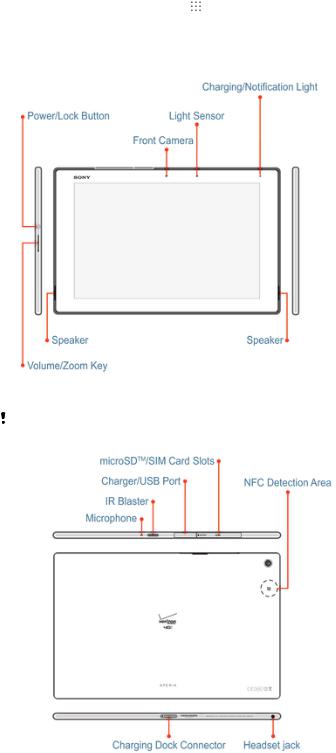
Getting started
About this User guide
This is the Xperia™ Z2 Tablet User guide for the Android™ 4.4 software version. If you're not sure which software version your device is running, you can check it via the Settings menu.
To check the current software version of your device
1 From your Home screen, tap .
2Find and tap Settings > About tablet > Android version.
Tablet Features
Not all features, apps or services may be available with your plan, device operating system and software version. Please contact Verizon Wireless for more information.
Devices and software are constantly evolving—the screen images and icons you see here are for reference only.
5
This is an Internet version of this publication. © Print only for private use.
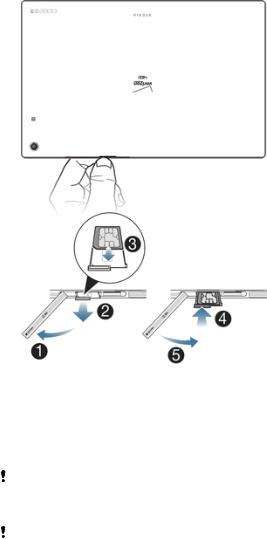
Setting Up Your Tablet
A protective plastic sheet is attached to the screen. You should peel off this sheet before using the touchscreen. Otherwise, the touchscreen might not function properly.
Inserting the SIM Card
1Open the SIM card slot cover.
2Using a fingernail, pull out the SIM card holder.
3Carefully insert the 4G LTE SIM card into the SIM card holder with the Verizon logo facing up.
4 Push the SIM card holder back into place.
5Close the SIM card slot cover.
Inserting the SIM card into the device without the SIM card holder could damage your SIM card or your device, and Sony Mobile does not warrant and will not be responsible for any damage caused by such action.
To ensure the water resistance of your device, the cover for the SIM card slot must be firmly closed.
6
This is an Internet version of this publication. © Print only for private use.

Removing the SIM Card
1Open the SIM card slot cover.
2 Using a fingernail, pull out the SIM card holder.
3Remove the SIM card.
4 Push the SIM card holder back into place.
5Close the SIM card slot cover.
To ensure the water resistance of your device, the cover for the SIM card slot must be firmly closed.
Inserting the microSD Card
1Open the microSD card slot cover.
2Carefully slide the microSD card into the microSD slot with the gold contacts
facing down
3Close the microSD slot cover.
To remove the microSD card, carefully push the card inward to release it from the slot.
To ensure the water resistance of your device, the cover for the microSD card slot must be firmly closed.
7
This is an Internet version of this publication. © Print only for private use.

Starting your device for the first time
The first time you start your device, a Setup Wizard opens to help you configure basic settings, sign in to some accounts, and personalize your device. For example, if you have a Sony Entertainment Network account, you can sign in to it here and get set up straight away.
You can also access the Setup Wizard later from the application menu to know more about your tablet.
Turning Your Tablet On/Off
It’s important to fully charge the battery before turning on your tablet.
To turn on your tablet
•Press and hold the Power/Lock button on the left side of your tablet.
To turn off your tablet
1 Press and hold the Power/Lock button until the Device options screen appears.
2Tap Power off > OK.
Why do I need a Google™ account?
Your Xperia™ device from Sony runs on the Android™ platform developed by Google™. A range of Google™ applications and services are available on your device when you purchase it, for example, Gmail™, Google Maps™, YouTube™, and Google Play™—the online store for downloading Android™ applications. To get the most out of these services, you need a Google™ account. For example, a Google™ account is mandatory if you want to:
•Download and install applications from Google Play™.
•Synchronize email, contacts, and the calendar.
•Chat with friends using the Hangouts™ application.
•Synchronize your browsing history and bookmarks.
For more information about Android™ and Google™, go to www.sonymobile.com/support.
To set up a Google™ account on your device
1 From your Home screen, tap .
2Find and tap Settings > Add account > Google.
3Follow the registration wizard to create a Google™ account, or sign in if you already have an account.
You can also sign in to or create a Google™ account from the setup wizard the first time you start your device. Or you can go online and create an account at www.google.com/accounts.
Charging Your Tablet
Your device has an embedded, rechargeable battery that should be replaced only by Sony or an authorized Sony repair center. You should never try to open or take apart this device yourself. Opening the device can cause damage that will void your warranty.
8
This is an Internet version of this publication. © Print only for private use.
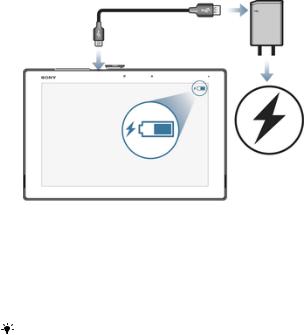
The battery is partly charged when you buy the device. You can still use your device while it is charging. Read more about the battery and how to improve the performance in
Battery and power management on page 87.
To charge your device
1 Plug the charger into a power outlet.
2 Plug one end of the USB cable into the charger (or into the USB port of a computer).
3Plug the other end of the cable into the micro USB port on your device, with the USB symbol facing up. The notification light illuminates when charging begins.
4When the device is fully charged, disconnect the cable from your device by pulling it straight outward. Make sure not to bend the connector.
If the battery is completely discharged, it may take a few minutes before the notification light illuminates and the charging icon  appears.
appears.
Battery notification light status
Green |
The battery charge level is greater than 90% |
|
|
Flashing red |
The battery is charging and the battery charge level is less than 15% |
|
|
Orange |
The battery is charging and the battery charge level is less than 90% |
|
|
9
This is an Internet version of this publication. © Print only for private use.
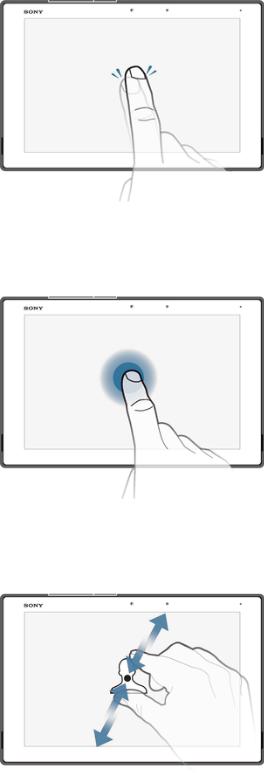
Learning the basics
Using the touchscreen
Tapping
•Open or select an item.
•Mark or unmark a checkbox or option.
•Enter text using the on-screen keyboard.
Touching and holding
•Move an item.
•Activate an item-specific menu.
•Activate selection mode, for example, to select several items from a list.
Pinching and spreading
•Zoom in or out on a web page, a photo, or a map.
10
This is an Internet version of this publication. © Print only for private use.

Swiping
•Scroll up or down a list.
•Scroll left or right, for example, between Home screen panes.
Flicking
•Scroll quickly, for example, in a list or on a web page. You can stop the scrolling movement by tapping the screen.
Locking and unlocking the screen
When your device is on and left idle for a set period of time, the screen darkens to save battery power and locks automatically. This lock prevents unwanted actions on the touchscreen when you are not using it. When you buy your device, a basic screen swipe lock is already set. This means that you have to swipe in any direction from the right side of the screen to unlock it. You can change the security settings later and add other kinds of locks. See Screen lock on page 31.
To activate the screen
•Briefly press the power key  .
.
11
This is an Internet version of this publication. © Print only for private use.
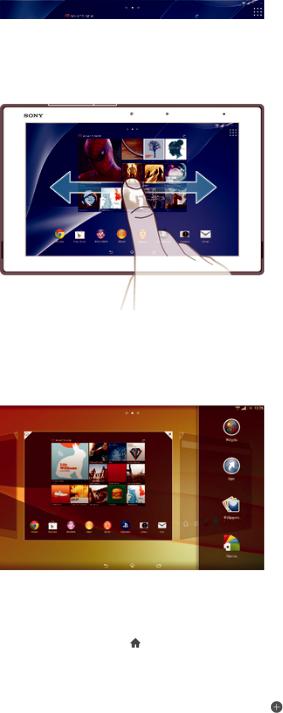
To unlock the screen
•Place a finger on the right side of the screen and swipe in any direction.
To lock the screen
•When the screen is active, briefly press the power key  .
.
Home screen
The Home screen is the starting point for using your device. It's similar to the desktop on a computer screen. Your Home screen can have up to seven panes, which extend beyond the regular screen display width. The number of Home screen panes is represented by a series of dots at the top of the Home screen. The highlighted dot shows the pane that you are currently in.
To go to the Home screen
•Press  .
.
To browse the Home screen
Home screen panes
You can add new panes to your Home screen (up to a maximum of seven panes) and delete panes. You can also set the pane that you want to use as the main Home screen pane.
|
To set a pane as the main Home screen pane |
1 |
Touch and hold an empty area on your Home screen until the device vibrates. |
2 |
Flick left or right to browse to the pane that you want to set as your main Home |
|
screen pane, then tap at the top corner of the pane. |
|
To add a pane to your Home screen |
1 |
Touch and hold an empty area on your Home screen until the device vibrates. |
2 |
Flick left or right to browse the panes, then tap . |
|
12 |
This is an Internet version of this publication. © Print only for private use.

To delete a pane from your Home screen
1Touch and hold an empty area on your Home screen until the device vibrates.
2Flick left or right to browse to the pane that you want to delete, then tap  .
.
Application screen
The Application screen, which you open from the Homescreen, contains the applications that come pre-installed on your device as well as applications that you download.
To view all applications on the Application screen
1From your Home screen, tap .
2 |
Flick left or right on the Application screen. |
|
To open an application from the Application screen |
• |
Flick left or right to find the application, then tap the application. |
|
To open the Application screen menu |
• |
When the Application screen is open, drag the left edge of the screen to the right. |
|
To move an application on the Application screen |
1 |
To open the Application screen menu, drag the left edge of the Application screen |
|
to the right. |
2 |
Make sure Own order is selected under SHOW APPS. |
3 |
Touch and hold the application until it magnifies and the device vibrates, then drag |
|
it to the new location. |
|
To add an application shortcut to the Home screen |
1 |
From the Application screen, touch and hold an application icon until the screen |
2 |
vibrates, then drag the icon to the top of the screen. The Home screen opens. |
Drag the icon to the desired location on the Home screen, then release your |
|
|
finger. |
|
To arrange applications on the Application screen |
1 |
To open the Application screen menu, drag the left edge of the Application screen |
|
to the right. |
2 |
Select the desired option under SHOW APPS. |
|
To search for an application from the Application screen |
1 |
To open the Application screen menu, drag the left edge of the Application screen |
|
to the right. |
2 |
Tap Search apps. |
3Enter the name of the application you want to search for.
To uninstall an application from the Application screen
1To open the Application screen menu, drag the left edge of the Application screen to the right.
2 Tap Uninstall. All uninstallable applications are indicated by .
3Tap the application that you want to uninstall, then tap Uninstall.
13
This is an Internet version of this publication. © Print only for private use.

Navigating applications
You can navigate between applications using the navigation keys, the small apps bar, and the recently used applications window, which lets you switch easily between all recently used applications. Some applications are closed when you press  to exit while others continue to run in the background or pause. If the application is paused or runs in the background, you can continue where you left off the next time you open the application.
to exit while others continue to run in the background or pause. If the application is paused or runs in the background, you can continue where you left off the next time you open the application.
1Recently used applications window – Open a recently used application
2Favorites bar – Open a shortcut for applications or widgets
3Task navigation key – Open the recently used applications window and the small apps bar
4Home navigation key – Exit an application and go back to the Home screen
5Back navigation key – Go back to the previous screen within an application or close the application
To open the recently used applications window
•Press  .
.
To close all the recently used applications
•Tap  and then tap Close all.
and then tap Close all.
To open a menu in an application
•While using the application, press  .
.
A menu is not available in all applications.
Small apps
A small app is a shortcut used for applications and widgets. You can get quick access to the small apps at any time using the favorites bar. A small app only takes up a small area of your screen, so you can interact with a small app and another application at the same time on the same screen. For example, you can have a web page open and then open the Calculator small app on top of it and perform calculations. You can download more small apps from Google Play™.
To open a small app
1 To make the favorites bar appear, press .
2Tap the small app that you want to open.
To close a small app
•Tap  on the small app window.
on the small app window.
To download a small app
1From the small apps bar, tap , then tap and tap .
2Search for the small app that you want to download, then follow the instructions to download it and complete the installation.
14
This is an Internet version of this publication. © Print only for private use.

To move a small app
•When the small app is open, touch and hold the top left corner of the small app, then move it to the desired location.
To minimize a small app
•When the small app is open, touch and hold the top left corner of the small app, then drag it to the right edge or to the bottom edge of the screen.
To minimize a small app, you can also drag down the status bar to open the Notification panel and then tap  .
.
To rearrange the small apps in the small apps bar
•Touch and hold a small app and drag it to the desired position.
To remove a small app from the small apps bar
•Touch and hold a small app, then drag it to  .
.
To restore a previously removed small app
1 |
Open the small apps bar, then tap |
. |
|
2 |
Touch and hold the small app you want to restore, then drag it into the small apps |
||
|
bar. |
|
|
|
To add a widget as a small app |
|
|
1 |
To make the small apps bar appear, press . |
||
2 |
Tap |
> > . |
|
3Select a widget.
4Enter a name for the widget, if desired, then tap OK.
Widgets
Widgets are small applications that you can use directly on your Homescreen. They also function as shortcuts. For example, the Weather widget allows you to see basic weather information directly on your Homescreen. But when you tap the widget, the full Weather application opens. You can download additional widgets from Google Play™.
To add a widget to the Home screen
1Touch and hold an empty area on your Home screen until the device vibrates,
2 |
then tap Widgets. |
Find and tap the widget that you want to add. |
|
|
To resize a widget |
1 |
Touch and hold a widget until it magnifies and the device vibrates, then release |
|
the widget. If the widget can be resized, for example, the Calendar widget, then a |
2 |
highlighted frame and resizing dots appear. |
Drag the dots inward or outward to shrink or expand the widget. |
3To confirm the new size of the widget, tap anywhere on the Home screen.
15
This is an Internet version of this publication. © Print only for private use.

To move a widget
•Touch and hold the widget until it magnifies and the device vibrates, then drag it to the new location.
To delete a widget
•Touch and hold the widget until it magnifies and the device vibrates, then drag it to  .
.
|
To add a widget to the lock screen |
1 |
From your Home screen, tap , then find and tap Settings > Security |
2 |
Mark the Allow widgets on lock screen checkbox. |
3Press the power key to lock the screen.
4To activate the screen, briefly press the power key .
5Swipe inwards from the middle of the left side of the screen until  appears, then tap it.
appears, then tap it.
6 If required, enter your PIN code, pattern or password to unlock the screen.
7Find and tap the widget that you want to add.
8Follow the on-screen instructions, if necessary, to finish adding the widget.
Shortcuts and folders
Use shortcuts and folders to manage your applications and keep your Home screen tidy.
1Access a folder containing applications
2Access an application using a shortcut
To add an application shortcut to your Home screen
1Touch and hold an empty area on your Home screen until the device vibrates and the customization menu appears.
2In the customization menu, tap Apps.
3Scroll through the list of applications and select an application. The selected application gets added to the Home screen.
In step 3, alternatively, you can tap Shortcuts and then select an application from the list available. If you use this method to add shortcuts, some of the applications available allow you to add specific functionality to the shortcut.
To move an item on the Home screen
•Touch and hold the item until it magnifies and the device vibrates, then drag the item to the new location.
To delete an item from the Home screen
•Touch and hold an item until it magnifies and the device vibrates, then drag the item to  .
.
To create a folder on the Home screen
•Touch and hold an application icon or a shortcut until it magnifies and the device vibrates, then drag and drop it on top of another application icon or shortcut.
16
This is an Internet version of this publication. © Print only for private use.
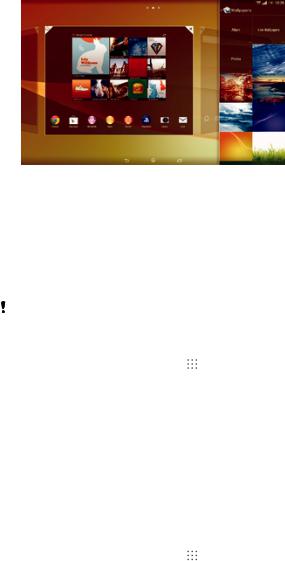
To add items to a folder on the Home screen
•Touch and hold an item until it magnifies and the device vibrates, then drag the item to the folder.
To rename a folder on the Home screen
1Tap the folder to open it.
2 Tap the folder's title bar to show the Folder name field.
3Enter the new folder name and tap Done.
Background and themes
You can adapt the Home screen to your own style using wallpapers and different themes. You can also change the wallpaper on the lock screen.
To change your Home screen wallpaper
1 Touch and hold an empty area on your Home screen until the device vibrates.
2Tap Wallpapers and select an option.
To set a theme
1 Touch and hold an empty area on your Home screen until the device vibrates.
2Tap Themes, then select a theme.
When you change a theme, the background also changes in some applications.
To change the wallpaper for the lockscreen
1 From your Homescreen, tap .
2Find and tap Settings > Personalization > Lock screen.
3Select an option, then follow the instructions to change your wallpaper.
|
Status and notifications |
|
The icons in the status bar inform you of events such as new messages and calendar |
|
notifications, activities in progress such as file downloads, and status information such as |
|
battery level and signal strength. You can drag down the status bar to open the |
|
Notification panel and handle your notifications. |
|
To select which system icons to display in the status bar |
1 |
From your Homescreen, tap . |
2 |
Find and tap Settings > Personalization > Status bar icons. |
3Select the icons you want to display.
17
This is an Internet version of this publication. © Print only for private use.

To open or close the Notification panel
|
To select the apps allowed to send notifications |
1 |
From your Homescreen, tap . |
2 |
Find and tap Settings > Personalization > Manage notifications. |
3 |
Select the apps that are allowed to send notifications. |
To take action on a notification
•Tap the notification.
To dismiss a notification from the Notification panel
•Place your finger on a notification and flick left or right.
To clear all notifications from the Notification panel
•Tap Clear.
Notification light
A notification light informs you about battery status and other events.
Icons in the status bar
Status icons
Signal strength
No signal
Mobile hotspot is on
4G LTE is connected
4G LTE is in use
Network extender
Roaming
3G is available
Sending and downloading 3G data
18
This is an Internet version of this publication. © Print only for private use.
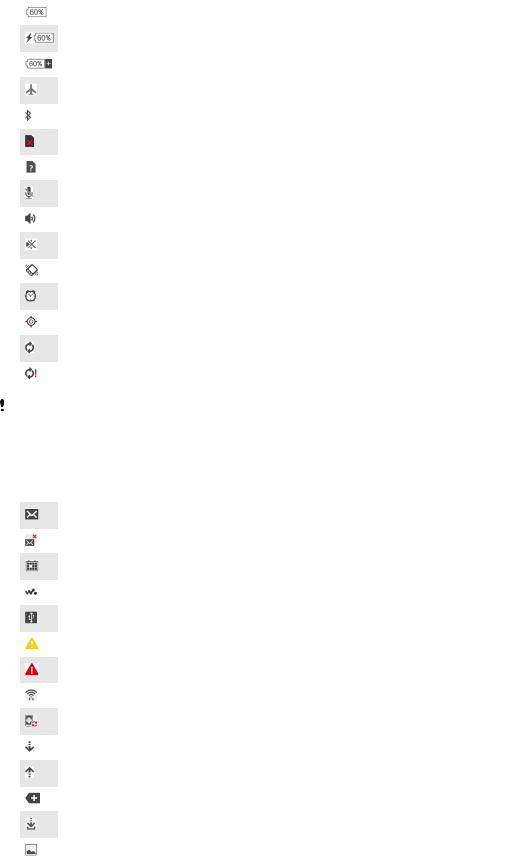
Battery status
The battery is charging
STAMINA mode is activated
Airplane mode is activated
The Bluetooth® function is activated
The SIM card is not inserted
The SIM card is an unknown SIM
The microphone is muted
The speakerphone is on
Silent mode
Vibrate mode
An alarm is set
GPS is activated
Synchronization is ongoing
Problem with sign-in or synchronization
Depending on your service provider, network and/or region, the functions or services represented by some icons in this list may not be available.
Notification icons
The following notification icons may appear on your screen:
New email message
Email not sent
Upcoming calendar event
A song is playing
The device is connected to a computer via a USB cable
Warning message
Error message
A Wi-Fi® connection is enabled and wireless networks are available Software updates are available
Downloading data
Uploading data
More (undisplayed) notifications
Download successful
Screenshot
19
This is an Internet version of this publication. © Print only for private use.
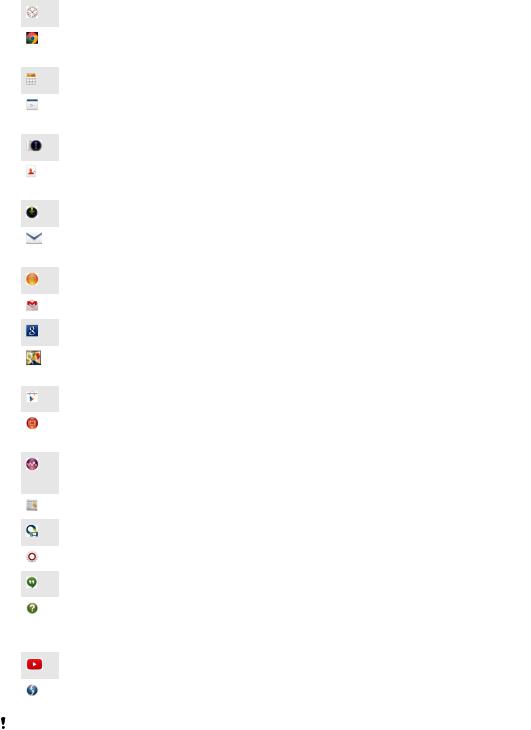
Application overview
Use the Alarm and clock application to set various kinds of alarms.
Use your web browser to navigate and view web pages, manage bookmarks, and manage text and images.
Use the Calculator application to perform basic calculations.
Use the Calendar application to keep track of your events and manage your appointments.
Use the camera to take photos and record video clips.
Use the Contacts application to manage phone numbers, email address and other information related to your contacts.
Access your downloaded applications.
Use the Email application to send and receive emails through both private and corporate accounts.
Use the Album application to view and to work with your photos and videos.
Use the Gmail™ application to read, write and organize email messages.
Search for information in your device and on the web.
View your current location, find other locations, and calculate routes using Google Maps™.
Go to Google Play™ to download free and paid applications for your device.
Use the Movies application to play videos in your device and share content with your friends.
Use the "WALKMAN" application to organize and play music, audio books and podcasts.
View news stories and weather forecasts.
Use the Video Unlimited application to rent and purchase videos.
Optimize settings to suit your own requirements.
Use the Hangouts™ application to chat with friends online.
Use the Help application to read Get started guide and User guide, get to know icon glossary, view your usage and customize your features of Verizon mobile, and watch help videos and other product-related information.
Use YouTube™ to share and view videos from around the world.
Download and install new applications and updates.
Some applications are not supported by all networks and/or service providers in all areas.
20
This is an Internet version of this publication. © Print only for private use.

|
Downloading applications |
|
Downloading applications from Google Play™ |
|
Google Play™ is the official online Google store for downloading applications, games, |
|
music, movies and books. It includes both free and paid applications. Before you start |
|
downloading from Google Play™, make sure that you have a working Internet |
|
connection, preferably over Wi-Fi® to limit data charges. |
|
To use Google Play™, you need to have a Google™ account. Google Play™ may not be |
|
available in all countries or regions. |
|
To download an application from Google Play™ |
1 |
From the Home screen, tap . |
2 |
Find and tap Play Store. |
3 |
Find an item you wish to download by browsing categories, or by using the search |
function.
4Tap the item to view its details, and follow the instructions to complete the installation.
Some applications may need to access data, settings and various functions on your device in order to work properly. Only install and give permissions to applications that you trust.
You can view the permissions granted to a downloaded application by tapping the application under Settings > Application manager.
Downloading applications from other sources
When your device is set to allow downloads from sources other than Google Play™, you can download applications directly from other websites by following the relevant download instructions.
Installing applications of unknown or unreliable origin can damage your device. Only download applications from reliable sources. Contact the application provider if you have any questions or concerns.
To allow the download of applications from other sources
1 From your Home screen, tap .
2Find and tap Settings > Security.
3 Mark the Unknown sources checkbox.
4Tap OK.
Some applications may need to access data, settings and various functions on your device in order to work properly. Only install and give permissions to applications you trust.
You can view the permissions granted to a downloaded application by tapping the application under Settings > Application manager.
21
This is an Internet version of this publication. © Print only for private use.

|
Internet and networks |
|
Browsing the web |
|
Use Google Chrome™ for Android™ to browse the web. |
|
To browse with Google Chrome™ |
1 |
From your Home screen, tap . |
2 |
Find and tap . |
3 |
If you are using Google Chrome™ for the first time, select to either sign in to a |
Google™ account or browse with Google Chrome™ anonymously.
4Enter a search term or web address in the search and address field, then tap Go on the keyboard.
Wi-Fi®
Use Wi-Fi® connections to surf the Internet, download applications, or send and receive email. Once you have connected to a Wi-Fi® network, your device remembers the network and automatically connects to it the next time you come within range.
Some Wi-Fi® networks require you to log in to a web page before you can get access. Contact the relevant Wi-Fi® network administrator for more information.
Available Wi-Fi® networks may be open or secured:
•Open networks are indicated by  next to the Wi-Fi® network name.
next to the Wi-Fi® network name.
•Secured networks are indicated by  next to the Wi-Fi® network name.
next to the Wi-Fi® network name.
Some Wi-Fi® networks do not show up in the list of available networks because they do not broadcast their network name (SSID). If you know the network name, you can add it manually to your list of available Wi-Fi® networks.
To turn on Wi-Fi®
1 From your Home screen, tap .
2Find and tap Settings.
3Drag the slider beside Wi-Fi to the right to turn on the Wi-Fi® function.
It may take a few seconds before Wi-Fi® is enabled.
|
To connect to a Wi-Fi® network automatically |
1 |
From your Home screen, tap . |
2 |
Find and tap Settings. |
3Tap Wi-Fi. All available Wi-Fi® networks are displayed.
4Tap a Wi-Fi® network to connect to it. For secured networks, enter the relevant password.  is displayed in the status bar once you are connected.
is displayed in the status bar once you are connected.
To search for new available networks, tap  , and then tap Scan.
, and then tap Scan.
To add a Wi-Fi® network manually
1 From your Home screen, tap .
2Find and tap Settings > Wi-Fi.
3 Tap .
4Enter the Network SSID information.
5 To select a security type, tap the Security field.
6If required, enter a password.
7To edit some advanced options such as proxy and IP settings, mark the Show advanced options checkbox and then edit as desired.
8Tap Save.
Contact your Wi-Fi® network administrator to get the network SSID and password.
22
This is an Internet version of this publication. © Print only for private use.
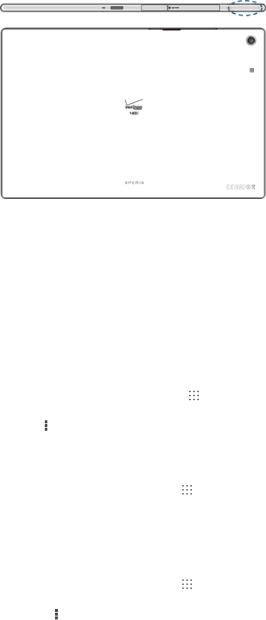
Increasing Wi-Fi® signal strength
There are a number of things you can do to increase the strength of a Wi-Fi® signal:
•Move your device closer to the Wi-Fi® access point.
•Move the Wi-Fi® access point away from any potential obstructions or interference.
•Don’t cover the Wi-Fi® antenna area of your device (the highlighted area in the illustration).
Wi-Fi® settings
When you are connected to a Wi-Fi® network or when there are Wi-Fi® networks available in your vicinity, it is possible to view the status of these networks. You can also enable your device to notify you whenever an open Wi-Fi® network is detected.
If you are not connected to a Wi-Fi® network, your device requires a mobile data connection to access the Internet. By adding a Wi-Fi® sleep policy, you can specify when to switch from Wi-Fi® to mobile data.
To enable Wi-Fi® network notifications
1Turn on Wi-Fi®, if it is not already on.
2 From your Home screen, tap .
3Find and tap Settings > Wi-Fi.
4Tap > Advanced.
5Mark the Wi-Fi notifications checkbox.
To view detailed information about a connected Wi-Fi® network
1 From the Home screen, tap .
2Find and tap Settings > Wi-Fi.
3Tap the Wi-Fi® network that you are currently connected to. Detailed network information is displayed.
|
To add a Wi-Fi® sleep policy |
1 |
From the Home screen, tap . |
2 |
Find and tap Settings > Wi-Fi. |
3Press .
4Tap Advanced.
5 Tap Keep Wi-Fi on during sleep.
6Select an option.
Sharing your mobile data connection
You can share your device's mobile data connection with a single computer using a USB cable. This process is called USB tethering. Similarly, you can share your device’s mobile data connection with other devices with NFC Wi-Fi® tethering or Bluetooth tethering.
You can also share your device's mobile data connection by turning your device into a portable Wi-Fi® hotspot. When your device's mobile data connection is successfully
23
This is an Internet version of this publication. © Print only for private use.

shared, the sharing devices can use your device's data connection, for example, to surf the Internet, download applications, or send and receive emails.
You may need to prepare your computer to establish a network connection via USB cable. Go to www.android.com/tether to get the most current information.
To share your data connection using a USB cable
1Deactivate all USB cable connections to your device.
2Using the USB cable that came with your device, connect your device to a computer.
3 |
From your Home screen, tap . |
4 |
Find and tap Settings > More… > Tethering & Mobile Hotspot. |
5 |
Mark the Mobile Broadband Connect checkbox, then tap OK if prompted. is |
displayed in the status bar once you are connected.
6To stop sharing your data connection, unmark the Mobile Broadband Connect checkbox or disconnect the USB cable.
You cannot share both your device's data connection and SD card over a USB cable at the same time.
To share your mobile connection by NFC Wi-Fi® tethering
1Make sure that both devices have the NFC function turned on, and that both screens are active.
2From your Home screen, tap .
3Find and tap Settings > More… > Tethering & Mobile Hotspot > NFC Wi-Fi tethering.
4Tap OK if prompted.
5Hold devices back to back so that the NFC detection areas of each device touch each other, and they will connect automatically.
This function only works with devices that also support NFC Wi-Fi tethering.
|
To use your device as Mobile Hotspot |
1 |
From your Home screen, tap . |
2 |
Find and tap Settings > More… > Tethering & Mobile Hotspot. |
3 |
Tap Mobile Hotspot settings > Set up Mobile Hotspot. |
4Enter the Network name (SSID) information.
5 To select a security type, tap the Security field. If required, enter a password.
6Tap Save.
7Tap and mark the Mobile Hotspot checkbox.
8If prompted, tap OK to confirm.  appears in the status bar once the portable WiFi® hotspot is active.
appears in the status bar once the portable WiFi® hotspot is active.
9To stop sharing your data connection via Wi-Fi®, unmark the Mobile Hotspot checkbox.
|
To rename or secure your Mobile Hotspot |
1 |
From the Home screen, tap . |
2 |
Find and tap Settings > More… > Tethering & Mobile Hotspot. |
3 |
Tap Mobile Hotspot settings > Set up Mobile Hotspot. |
4 |
Enter the Network name (SSID) information. |
5 |
To select a security type, tap the Security field. |
6 |
If required, enter a password. |
7Tap Save.
Controlling data usage
You can keep track of the amount of data transferred to and from your device over your mobile data or Wi-Fi® connection during a given period. For example, you can view the amount of data used by individual applications. For data transferred over your mobile
24
This is an Internet version of this publication. © Print only for private use.

data connection, you can also set data usage warnings and limits to avoid additional charges.
Adjusting data usage settings can help you keep greater control over data usage but cannot guarantee the prevention of additional charges.
To turn cellular data traffic on or off
1 From your Home screen, tap .
2Find and tap Settings > Data usage.
3Drag the slider beside Mobile data traffic accordingly to turn cellular data traffic on or off.
When cellular data traffic is turned off, your device can still establish Wi-Fi® and Bluetooth® connections.
To set a data usage warning
1Make sure cellular data traffic is turned on.
2 From your Home screen, tap .
3Find and tap Settings > Data usage.
4To set the warning level, drag the warning line to the desired value. You receive a warning notification when the amount of data traffic approaches the level you set.
To set a mobile data usage limit
1Make sure that mobile data traffic is turned on.
2 From your Home screen, tap .
3Find and tap Settings > Data usage.
4Mark the Limit mobile data usage checkbox if it is not marked, then tap OK.
5To set the mobile data usage limit, drag the corresponding line to the desired value.
Once your mobile data usage reaches the set limit, mobile data traffic on your device gets turned off automatically.
|
To control the cellular data usage of individual applications |
1 |
From your Home screen, tap . |
2 |
Find and tap Settings > Data usage. |
3Find and tap the desired application.
4Mark the Restrict background data checkbox.
5To access more specific settings for the application (if available), tap View app settings and make the desired changes.
The performance of individual applications may be affected if you change the related data usage settings.
To view data transferred via Wi-Fi®
1 From your Home screen, tap .
2Find and tap Settings > Data usage.
3 Tap , then mark the Show Wi-Fi usage checkbox if it is not marked.
4Tap the Wi-Fi tab.
Virtual private networks (VPNs)
Use your device to connect to virtual private networks (VPNs), which allow you to access resources inside a secured local network from a public network. For example, VPN connections are commonly used by corporations and educational institutions for users who need to access intranets and other internal services when they are outside of the internal network, for example, when they are traveling.
VPN connections can be set up in many ways, depending on the network. Some networks may require you to transfer and install a security certificate on your device. For detailed information on how to set up a connection to your virtual private network, please contact the network administrator of your company or organization.
25
This is an Internet version of this publication. © Print only for private use.

To add a virtual private network
1 From your Home screen, tap .
2Find and tap Settings > More… > VPN.
3Tap .
4 Select the type of VPN to add.
5 Enter your VPN settings.
6Tap Save.
To connect to a virtual private network
1 From your Home screen, tap .
2Find and tap Settings > More… > VPN.
3 In the list of available networks, tap the VPN you want to connect to. 4 Enter the required information.
5Tap Connect.
To disconnect from a virtual private network
1Drag the status bar downwards.
2Tap the notification for the VPN connection to turn it off.
26
This is an Internet version of this publication. © Print only for private use.

Synchronizing data on your device
Synchronizing with online accounts
Synchronize your device with contacts, email, calendar events, and other information from online accounts, for example, email accounts such as Gmail™ and Exchange ActiveSync, Facebook™, Flickr™, and Twitter™. You can synchronize data automatically for all accounts by activating the auto-sync function. Or you can synchronize each account manually.
To set up an online account for synchronization
1From your Home screen, tap .
2Tap Settings > Add account, then select the account you want to add.
3Follow the instructions to create an account, or sign in if you already have an account.
To activate the auto-sync function
1 From your Home screen, tap > Settings.
2Drag the slider beside Auto-sync to the right.
To synchronize manually with an online account
1From your Home screen, tap > Settings.
2Under Accounts, select the account type, then tap the name of the account you want to synchronize with. A list of items that can be synchronized with the account appears .
3 Mark the items you want to synchronize.
4Tap  , then tap Sync now.
, then tap Sync now.
To remove an online account
1From your Home screen, tap > Settings.
2Under Accounts, select the account type, then tap the name of the account you want to remove.
3Tap , then tap Remove account.
4Tap Remove account again to confirm.
Synchronizing with Microsoft® Exchange ActiveSync®
Using a Microsoft Exchange ActiveSync account, you can access your corporate email
messages, calendar appointments, and contacts directly on your device. After setup, you can find your information in the Email, Calendar, and Contacts applications.
To set up an EAS account for synchronization
1Make sure you have your domain and server details, provided by your corporate
2 |
network administrator, available. |
From your Home screen, tap . |
|
3 |
Tap Settings > Add account > Exchange ActiveSync. |
4Enter your corporate email address and password.
5Tap Next. Your device begins to retrieve your account information. If a failure
occurs, enter the domain and server details for your account manually and then tap Next.
6Tap OK to allow your corporate server to control your device.
7Select what data you want to sync with your device, such as contacts and calendar entries.
8If desired, activate the device administrator to allow your corporate server to control certain security features on your device. For example, you can allow your corporate server to set password rules and set storage encryption.
9When the setup is done, enter a name for the corporate account.
When you change the login password for an EAS account on your computer, you have to log in again to the EAS account on your device.
27
This is an Internet version of this publication. © Print only for private use.

|
To change the settings of an EAS account |
1 |
From your Home screen, tap . |
2 |
Tap Email, then tap . |
3Tap Settings and select an EAS account, then change the settings of the EAS account as desired.
|
To set a synchronization interval for an EAS account |
1 |
From your Home screen, tap . |
2 |
Tap Email, then tap . |
3Tap Settings and select an EAS account.
4Tap Account check frequency > Check frequency and select an interval option.
To remove an EAS account
1From your Home screen, tap > Settings.
2Under Accounts, tap Exchange ActiveSync, then select the EAS account you
want to remove.
3Tap , then tap Remove account.
4Tap Remove account again to confirm.
28
This is an Internet version of this publication. © Print only for private use.

|
Basic settings |
|
Accessing settings |
|
View and change settings for your device from the Settings menu. The Settings menu is |
|
accessible from both the Application screen and the Quick settings panel. |
|
To open the device settings menu from the Application screen |
1 |
From your Home screen, tap . |
2 |
Tap Settings. |
To open the Quick settings panel
•Drag the right side of the status bar downwards.
To select which quick settings to display on the Quick settings panel
1 Drag the right side of the status bar downwards, then tap Edit.
2Select the quick settings that you want to display.
To rearrange the Quick settings panel
1Drag the right side of the status bar downwards, then tap Edit.
2Touch and hold  beside a quick setting, then move it to the desired position.
beside a quick setting, then move it to the desired position.
Sound volume
You can adjust the volume for notifications, music and video playback. You can also set your device to silent mode so that it doesn't sound when you're in a meeting.
To adjust the sound volume with the volume key
•Press the volume key up or down.
To adjust the media playing volume with the volume key
•When playing music or watching video, press the volume key up or down.
To set your device to vibrate mode
•Press the volume key down until  appears in the status bar.
appears in the status bar.
You can also press and hold down the power key  and then tap
and then tap  in the menu that opens to set your device to vibrate mode.
in the menu that opens to set your device to vibrate mode.
To set your device to silent mode
1Press the volume key down until the device vibrates and appears in the status
2 |
bar. |
Press the volume key down again. appears in the status bar. |
|
|
To select the notification sound |
1 |
From your Home screen, tap . |
2 |
Find and tap Settings > Sound > Notification sound. |
3 |
Select the sound to be played when notifications arrive. |
4Tap Done.
To enable touch tones
1 From your Home screen, tap .
2Find and tap Settings > Sound.
3Mark the Touch sounds checkbox.
29
This is an Internet version of this publication. © Print only for private use.
